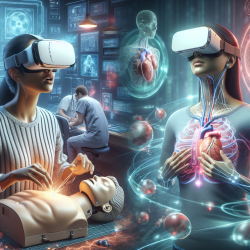Introduction
In the ever-evolving field of healthcare, the integration of technology into training programs has become crucial. The scoping review titled "The use of virtual reality and augmented reality to enhance cardio-pulmonary resuscitation: a scoping review" by Kuyt et al. (2021) offers valuable insights into how Virtual Reality (VR) and Augmented Reality (AR) are being utilized to improve cardiopulmonary resuscitation (CPR) training. This blog will delve into the findings of this research, emphasizing the potential of VR and AR to enhance CPR training and encouraging practitioners to explore these technologies further.
Understanding the Research
The scoping review conducted by Kuyt and colleagues utilized a standardized five-stage methodology to assess the efficacy of VR and AR in CPR training. The study identified 42 relevant articles published between 2009 and 2020, highlighting a significant increase in research from 2014 onwards. The review categorized the evidence using the Kirkpatrick model, which evaluates training interventions across four levels: reaction, learning, behavior, and results.
Key Findings
- Level 1 - Reaction: The research indicates a positive reception of VR and AR technologies among both instructors and trainees. Participants reported increased engagement and confidence in their CPR skills when trained using these technologies.
- Level 2 - Learning: VR and AR were found to enhance the acquisition of CPR skills, with studies showing that these methods are at least as effective as traditional training approaches.
- Level 3 - Behavior: Some studies demonstrated that trainees were able to apply their newly acquired skills in simulated scenarios, suggesting that VR and AR can effectively bridge the gap between learning and real-world application.
- Level 4 - Results: While the review did not find direct evidence of improved patient outcomes, the potential for VR and AR to enhance CPR training suggests a promising avenue for future research.
Implications for Practitioners
The findings of this scoping review underscore the potential of VR and AR to revolutionize CPR training. For practitioners, this presents an opportunity to incorporate cutting-edge technology into their training programs, thereby enhancing the learning experience and potentially improving patient outcomes. By leveraging VR and AR, practitioners can offer more immersive and engaging training sessions, which may lead to better retention of skills and increased confidence among trainees.
Encouraging Further Research
While the review highlights the promise of VR and AR in CPR training, it also points to the need for further research. Practitioners are encouraged to contribute to this growing body of knowledge by exploring the application of these technologies in various training contexts. Collaboration and consistency in research methodologies will be key to advancing the field and ensuring that VR and AR can be effectively integrated into CPR training programs worldwide.
Conclusion
As VR and AR technologies continue to evolve, their application in CPR training holds great potential. Practitioners are encouraged to embrace these innovations, explore their benefits, and contribute to the ongoing research efforts. By doing so, we can collectively enhance CPR training and ultimately improve outcomes for patients in critical situations.
To read the original research paper, please follow this link: The use of virtual reality and augmented reality to enhance cardio-pulmonary resuscitation: a scoping review.










